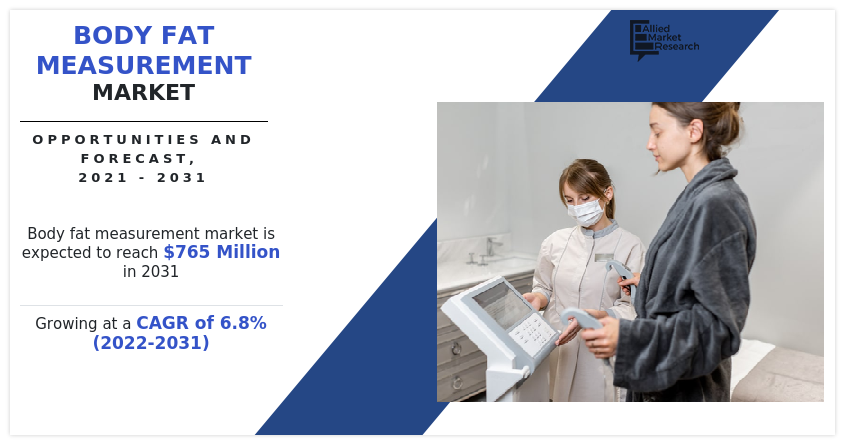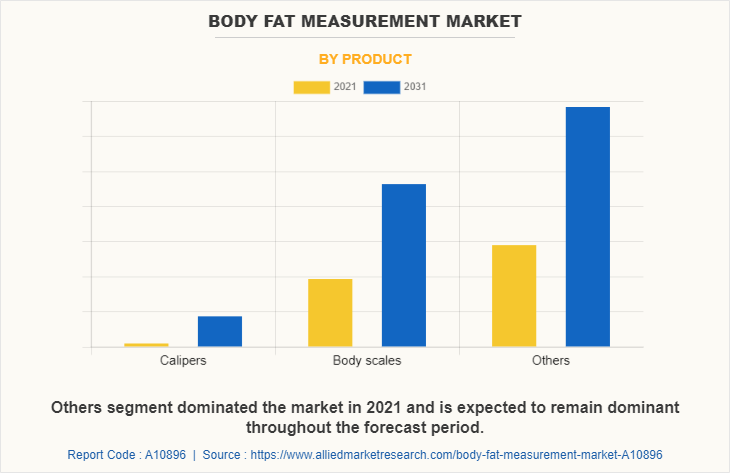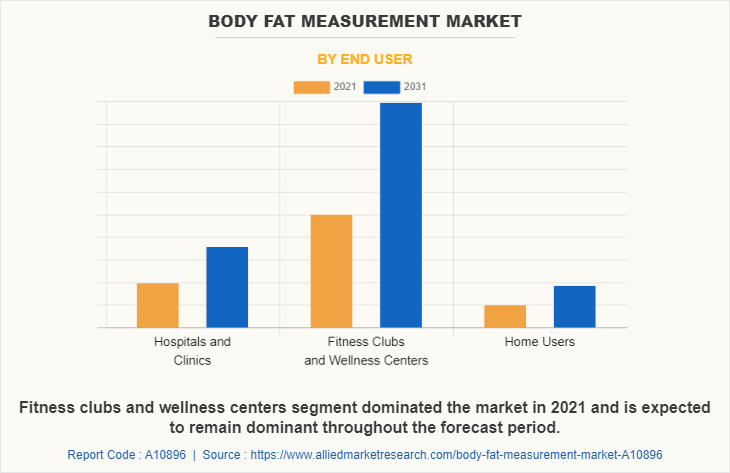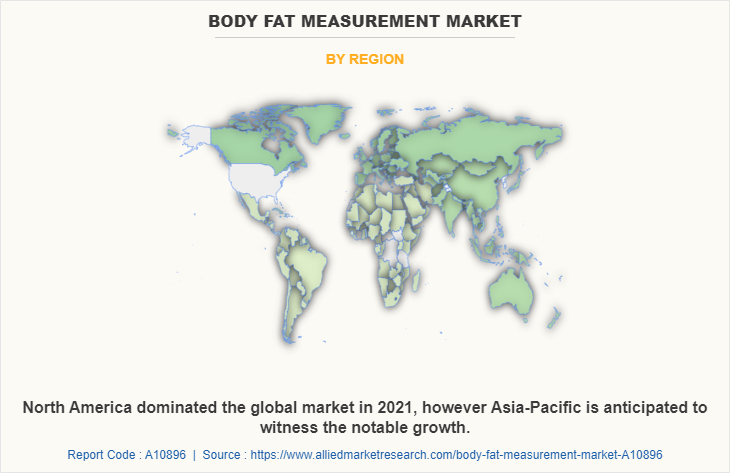Body Fat Measurement Market Research, 2031
The global body fat measurement market was valued at $395.13 million in 2021, and is projected to reach $765.00 million by 2031, growing at a CAGR of 6.8% from 2022 to 2031. Body fat is measured to access health status of an individual. Increase in body fat leads to obesity, which could be the reason for various diseases. Body fat percentage varies according to gender and age of person. Various factors such as adoption of unhealthy lifestyle, changes in eating habits, lack of physical mobility, and stress leads to obesity. Devices such as calipers, body scales, and others are used to measure body fat percentage. In addition, many techniques had been developed to detect body fat. Techniques such as bio-impedance analysis, hydrostatic weighing, air displacement plethysmography, dual emission X-ray absorptiometry, and others are used to measure body fat.

The drivers contributing to the body fat measurement market growth are increase in obesity among the global population and growth in awareness about healthy lifestyle among the population. In addition, rise in obesity due to modernization of lifestyle in developing economies and upsurge in the number of gyms and fitness clubs are the key trends of the market expected to fuel the growth of the body fat measurement industry during the forecast period. The rapid rise in obesity, especially in urban areas, drives the growth of the body fat measurement market.
Furthermore, government initiatives for promoting healthy lifestyle propel the body fat measurement market. Surge in the number of health-conscious consumers is expected to boost the demand for health clubs and gymnasiums However, high cost of body fat measuring devices and stringent regulatory framework are expected to impede the market growth. High price of body fat measurement devices is a major restraining factor of the market, as this leads to increase in demand for reused products. However, increasing awareness for healthy fit body is expected to increase the body fat measurement market opportunity.
Impact of COVID-19
The COVID-19 outbreak is anticipated to have a negative impact on the body fat measurement market. A huge number of clinics and hospitals across the globe were restructured to increase hospital capacity for patients diagnosed with COVID-19. Non-essential procedures took a potential backlog, owing to rapidly rising COVID-19 cases. The lockdown led to disruption of manufacturing and transportation of healthcare essentials. Furthermore, other factors responsible for the impact on the market include, limited availability of medical care, shortage of healthcare staff, and rise in burden of COVID-19 related hospitalization.
Public health recommendation, such as closers of parks, gyms, and fitness centers to prevent SARS-COV-2 spread have reduced daily physical activities. These factors minimized the demand for body fat measurement devices for monitoring health during lockdowns.
Body Fat Measurement Market Segmentation
The body fat measurement market is segmented into product, technique, end user and region. On the basis of product, the market is categorized into calipers, body scales, and others. By technique, it is divided into bio-impedance analysis, air displacement plethysmography, dual emission X-ray absorptiometry, hydrostatic weighing, and others. By end user, it is segmented into hospitals & clinics, fitness clubs & wellness centers, and home users. Region-wise, it is analyzed across North America, Europe, Asia-Pacific, and Latin America, the Middle East, and Africa (LAMEA).
Segment Review
By product, the market is segmented into calipers, body scales, and others. The others segment dominated the body fat measurement market size in 2021, and is also expected to witness highest CAGR of 7.2% during the body fat measurement market forecast period, owing to availability of various analyzers, monitoring devices, various product launch and technological advancements.

Depending on technique, the market is divided into bio-impedance analysis, air displacement plethysmography, dual emission X-ray absorptiometry, hydrostatic weighing, and others. The bio-impedance analysis segment dominated the body fat measurement market size in 2021, and is also expected to witness highest CAGR of 7.4% during the forecast period owing to its accuracy, rapid results, comfortable usage for elderly & children, and ease of handling of devices.

Depending on end user, the market is divided into hospitals & clinics, fitness club & wellness centers, and home users. The fitness club & wellness centers segment dominated the body fat measurement market size in 2021, and is also expected to witness highest CAGR of 7.1% during the forecast period owing to surge in the gyms & wellness centers offering such facilities and increase in healthy lifestyle awareness among the population.

Region-wise, North America is expected to account for the highest body fat measurement market share, owing to, advanced technology and availability of key players across the region, followed by Europe, Asia-Pacific, and LAMEA. Asia-Pacific is expected to register the fastest CAGR during the forecast period, due to increase in rapid development in healthcare technology, and increase in the number of facilities offering such services. Moreover, India and China are expected to witness growth at high CAGR in the body fat measurement market of Asia-Pacific.

The major players profiled in the report are Accufitness, LLC, Beurer GmbH, Bodystat Ltd., Charder Electronic Co, Ltd., Cosmed S.R.L, Diagnostic Medical Systems, Garmin Ltd., General Electric Company (GE Healthcare), Hologic Inc., Inbody Co. Ltd., Koninklijke Philips N.V, Omron Corporation, RJL Systems Inc, Selvas AI Inc. (Jawon Medical Co. Ltd.), Seca GmbH & CO.KG., Tanita Corporation, and Withings.
Key Benefits For Stakeholders
- This report provides a quantitative analysis of the market segments, current trends, estimations, and dynamics of the body fat measurement market analysis from 2021 to 2031 to identify the prevailing body fat measurement market opportunities.
- The market research is offered along with information related to key drivers, restraints, and opportunities.
- Porter's five forces analysis highlights the potency of buyers and suppliers to enable stakeholders make profit-oriented business decisions and strengthen their supplier-buyer network.
- In-depth analysis of the body fat measurement market segmentation assists to determine the prevailing market opportunities.
- Major countries in each region are mapped according to their revenue contribution to the global market.
- Market player positioning facilitates benchmarking and provides a clear understanding of the present position of the market players.
- The report includes the analysis of the regional as well as global body fat measurement market trends, key players, market segments, application areas, and market growth strategies.
Body Fat Measurement Market Report Highlights
| Aspects | Details |
| By End User |
|
| By Product |
|
| By Technique |
|
| By Region |
|
| Key Market Players | Omron Corporation, SECA GmbH and CO.KG., General Electric Company (GE Healthcare), Inbody co., Ltd, Withings, Garmin Ltd., Koninklijke Philips N.V, Hologic, Inc., Tanita corporation, Accufitness, LLC, Cosmed S.R.L, RJL Systems, Inc, SELVAS AI INC. (JAWON MEDICAL CO., LTD.), Charder Electronic co, Ltd., Diagnostic Medical Systems, beurer gmbh, Bodystat Ltd |
Analyst Review
With rise in obese population, development of advanced and reliable tools for body fat measurement has led to extensive number of applications of this technique. Increase in economic strength of developing nations, such China, India, and rise in healthcare expenditure are expected to drive the market during the forecast period.
The body fat measurement market holds a high potential, owing to innovative concepts and multidisciplinary expertise demand for new technological advancements in the creation of body fat measurement equipment. The opportunities for key market players are anticipated to expand with the increase in demand for pain-free and quick body fat measurement techniques. A bio-impedance analyzer is employed in modern techniques of body fat measurement. Obesity is a growing public health issue in both, developed and developing countries. Thus, rise in awareness of people towards healthy lifestyles is anticipated to drive the growth of the body fat measurement market in the future.
The forecast period for body fat measurement market is 2022 to 2031.
2021 is the base year considered for body fat measurement market.
The global body fat measurement market was valued at $395.13 million in 2021, and is estimated to reach $765 million by 2031, growing at a CAGR of 6.8% from 2022 to 2031.
Rise in awareness about healthy lifestyle and aesthetic enhancement among the population is the upcoming trend of the body fat measurement market.
The bio-impedance analysis is the leading technique in the body fat measurement market.
North America is the largest regional market for body fat measurement.
The major players profiled in the report are Accufitness, LLC, Beurer GmbH, Bodystat Ltd., Charder Electronic Co., Ltd, Cosmed S.R.L, Diagnostic Medical Systems, Garmin Ltd., General Electric Company (GE Healthcare), Hologic Inc., Inbody Co. Ltd., Koninklijke Philips N.V, Omron Corporation, RJL systems Inc, Selvas AI Inc. (Jawon Medical Co. Ltd.), Seca GmbH & CO.KG., Tanita Corporation, and Withings.
Loading Table Of Content...



